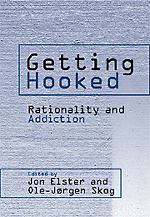Book contents
- Frontmatter
- Contents
- Preface and Acknowledgments
- Contributors
- Introduction
- Addiction and Social Interaction
- Addiction, Weakness of the Will, and Relapse
- The Dangers of Willpower
- The Neurobiology of Chemical Addiction
- To Legalize or Not to Legalize: Is That the Question?
- Rationality, Irrationality, and Addiction – Notes on Becker's and Murphy's Theory of Addiction
- Gambling and Addiction
- A Visceral Account of Addiction
- Epilogue: Rationally Coping with Lapses from Rationality
- Index
Gambling and Addiction
Published online by Cambridge University Press: 05 June 2012
- Frontmatter
- Contents
- Preface and Acknowledgments
- Contributors
- Introduction
- Addiction and Social Interaction
- Addiction, Weakness of the Will, and Relapse
- The Dangers of Willpower
- The Neurobiology of Chemical Addiction
- To Legalize or Not to Legalize: Is That the Question?
- Rationality, Irrationality, and Addiction – Notes on Becker's and Murphy's Theory of Addiction
- Gambling and Addiction
- A Visceral Account of Addiction
- Epilogue: Rationally Coping with Lapses from Rationality
- Index
Summary
Introduction
In this chapter, I discuss compulsive (excessive, pathological) gambling and whether it is usefully seen as an addiction. Compulsive gamblers are those who experience loss of self-control, by spending more than they intend (a within-episode phenomenon) or by quitting and then relapsing (a between-episode phenomenon). Following Dickerson (1984), an operational criterion is whether the gambler has sought help or treatment to control the gambling or to give it up altogether.
I shall rely on the general framework laid out in the introductory chapter and follow a similar subdivision of the topic. In Section 2, I give a brief overview of the main varieties of gambling behavior and their quantitative aspects, both in terms of the number of persons concerned and in terms of the amount of money involved. In Section 3, I discuss the phenomenology of gambling. In Section 4, I survey various explanations that have been offered of compulsive gambling. Section 5 offers a brief conclusion.
Before I proceed, let me note briefly that many of the general methodological issues raised in the introductory chapter can be illustrated by the specific case of gambling. Thus I agree fully with the following observation:
Scientific models of compulsive or excessive gambling are relatively new. Because compulsive gambling is one of the last excesses to be included under the addictive behaviors umbrella, theories of drug and alcohol addiction provide most of the early explanations of this phenomenon. […]
- Type
- Chapter
- Information
- Getting HookedRationality and Addiction, pp. 208 - 234Publisher: Cambridge University PressPrint publication year: 1999
- 3
- Cited by



